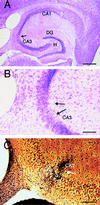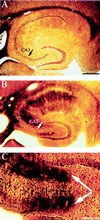Genetic determinants of susceptibility to excitotoxic cell death: implications for gene targeting approaches
- PMID: 9108112
- PMCID: PMC20575
- DOI: 10.1073/pnas.94.8.4103
Genetic determinants of susceptibility to excitotoxic cell death: implications for gene targeting approaches
Abstract
Recent studies have sought to identify the genes involved in excitotoxic neurodegeneration. Here we report that certain strains of mice, including strains that are used for gene targeting studies, do not exhibit excitotoxic cell death after kainic acid seizures. Kainic acid produced excitotoxic cell death in the CA3 and CA1 subfields of the hippocampus in 129/SvEMS and FVB/N mice, in the same pattern as described in rats. C57BL/6 and BALB/c mice exhibited excitotoxic cell death only at very high doses of kainate, and then only in a very restricted area, although they exhibited comparable seizures. Hybrids of 129/SvEMS x C57BL/6 mice created using embryonic stem cells from 129/SvEMS mice also did not exhibit excitotoxic cell death. These results demonstrate that C57BL/6 and BALB/c strains carry gene(s) that convey protection from glutamate-induced excitotoxicity. This differential susceptibility to excitotoxicity represents a potential complication for gene targeting studies.
Figures






Similar articles
-
Mouse strain differences in kainic acid sensitivity, seizure behavior, mortality, and hippocampal pathology.Neuroscience. 2003;122(2):551-61. doi: 10.1016/s0306-4522(03)00562-1. Neuroscience. 2003. PMID: 14614919
-
Congenic strains provide evidence that a mapped locus on chromosome 15 influences excitotoxic cell death.Genes Brain Behav. 2011 Feb;10(1):100-10. doi: 10.1111/j.1601-183X.2010.00644.x. Epub 2010 Sep 29. Genes Brain Behav. 2011. PMID: 20807240 Free PMC article.
-
Excitotoxic neurodegeneration induced by intranasal administration of kainic acid in C57BL/6 mice.Brain Res. 2002 Mar 29;931(2):135-45. doi: 10.1016/s0006-8993(02)02268-0. Brain Res. 2002. PMID: 11897099
-
Differences in ionotropic glutamate receptor subunit expression are not responsible for strain-dependent susceptibility to excitotoxin-induced injury.Brain Res Mol Brain Res. 2003 Apr 10;112(1-2):70-81. doi: 10.1016/s0169-328x(03)00048-2. Brain Res Mol Brain Res. 2003. PMID: 12670704
-
Genetic basis of kainate-induced excitotoxicity in mice: phenotypic modulation of seizure-induced cell death.Epilepsy Res. 2003 Aug;55(3):201-10. doi: 10.1016/s0920-1211(03)00115-3. Epilepsy Res. 2003. PMID: 12972174
Cited by
-
Proteolytic cleavage of Beclin 1 exacerbates neurodegeneration.Mol Neurodegener. 2018 Dec 29;13(1):68. doi: 10.1186/s13024-018-0302-4. Mol Neurodegener. 2018. PMID: 30594228 Free PMC article.
-
Neuroprotective role of dopamine against hippocampal cell death.J Neurosci. 2000 Nov 15;20(22):8643-9. doi: 10.1523/JNEUROSCI.20-22-08643.2000. J Neurosci. 2000. PMID: 11069974 Free PMC article.
-
Visualization of spatiotemporal energy dynamics of hippocampal neurons by mass spectrometry during a kainate-induced seizure.PLoS One. 2011 Mar 22;6(3):e17952. doi: 10.1371/journal.pone.0017952. PLoS One. 2011. PMID: 21445350 Free PMC article.
-
Gintonin, a Panax ginseng-derived LPA receptor ligand, attenuates kainic acid-induced seizures and neuronal cell death in the hippocampus via anti-inflammatory and anti-oxidant activities.J Ginseng Res. 2023 May;47(3):390-399. doi: 10.1016/j.jgr.2022.11.001. Epub 2022 Nov 14. J Ginseng Res. 2023. PMID: 37252272 Free PMC article.
-
Disruption of the ATP/adenosine balance in CD39-/- mice is associated with handling-induced seizures.Immunology. 2017 Dec;152(4):589-601. doi: 10.1111/imm.12798. Epub 2017 Aug 25. Immunology. 2017. PMID: 28742222 Free PMC article.
References
-
- A. A, Horrocks L A. Brain Res Rev. 1991;16:171–191. - PubMed
-
- Rothman S M, Olney J W. Trends Neurosci. 1987;10:299–302.
-
- Choi D W. Prog Brain Res. 1994;100:47–51. - PubMed
-
- Hori N, French-Mullen J H M, Carpenter D O. Brain Res. 1985;358:380–384. - PubMed
-
- Choi D W. Trends Neurosci. 1988;11:465–469. - PubMed
Publication types
MeSH terms
Substances
Grants and funding
LinkOut - more resources
Full Text Sources
Molecular Biology Databases
Miscellaneous

